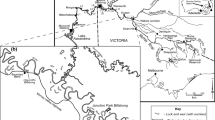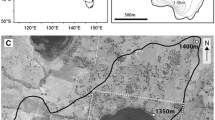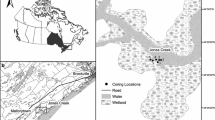Abstract
Cattails (Typha latifolia L., Typha angustifolia L., and Typha x glauca Godr.) are the predominant emergent vegetation of upper St. Lawrence River coastal wetlands. We sought to describe Holocene vegetation in a St. Lawrence River wetland to assess patterns of succession and examine the timing and potential causes of a historic cattail invasion. Paleoecological analysis indicated presence of four distinct wetland vegetation stages, including a shallow water marsh (8240 YBP to 5160 YBP), a variable-depth aquatic plant community with adjacent alder (5160 YBP to 1610 YBP), a shallow sedge community (1610 YBP to 100 YBP), and a robust emergent marsh (100 YBP to present). The record of pollen tetrads demonstrated cattail presence throughout the history of the marsh, but a rapid increase in relative abundance of Typha cf. angustifolia/Sparganium monads indicated major expansion of robust emergent plants beginning near the peak of agricultural activity (ca. 1880 AD) and reaching modern levels around 1940 AD. Increase in the abundance of robust emergents in this wetland occurred decades before regulation of St. Lawrence River water levels and were contemporary with increased sedimentation and changes associated with the early agricultural period.





Similar content being viewed by others
References
Anderson TW, Lewis CFM (1985) Postglacial water-level history on the Lake Ontario Basin. In: Karrow PF, Calkin PE (eds) Quaternary evolution of the great lakes. Geological Association of Canada Special Paper, 30, St. John’s, Newfoundland, pp 231–253
Appleby PG (2001) Chronostratigraphic techniques in recent sediments. In: Smol JP, Birks HJB, Last WM (eds) Tracking environmental change using lake sediments, volume 3: terrestrial, algal, and siliceous indicators. Kluwer Academic, Dordrecht, pp 171–203
Appleby PG, Oldfield F (1978) The calculation of lead-210 dates assuming a constant rate of supply of unsupported lead-210 to the sediment. Catena 5:1–8
Beland M (2003) Holocene vegetation dynamics of an upper St. Lawrence River coastal wetland and surrounding uplands: effects of climate change and anthropogenic disturbance. M.S. Thesis, State University of New York, College of Environmental Science and Forestry
Bennett KD, Willis KJ (2002) Pollen. In: Smol JP, Birks HJB, Last WM (eds) Tracking environmental change using lake sediments, volume 3: terrestrial, algal, and siliceous indicators. Kluwer Academic, Dordrecht, pp 5–32
Berglund BE (1986) Handbook of holocene palaeoecology and palaeohydrology. Wiley, Chinchester
Bernard JM, Solsky BA (1977) Nutrient cycling in a Carex lacustris wetland. Canadian Journal of Botany 55:630–638
Bickelhaupt DH, White EH (1982) Laboratory manual for soil and plant tissue analysis. State University of New York College of Environmental Science and Forestry, Syracuse
Bond MC (1954) Changes in New York State Agriculture, 1850–1950, as indicated by state and federal censuses. Department of Agricultural Economics, Cornell University, Ithaca
Byrd K, Kelly M (2006) Salt marsh vegetation response to edaphic and topographical changes from upland sedimentation in a Pacific estuary. Wetlands 26:813–829
Chen X, Driscoll CT (2009) Watershed land use controls on chemical inputs to Lake Ontario embayments. Journal of Environmental Quality 38:2084–2095
Chow-Fraser P, Lougheed V, Le Thiec V, Crosbie B, Simser L, Lord J (1998) Long-term response of the biotic community to fluctuating water levels and changes in water quality in Cootes Paradise Marsh, a degraded coastal wetland of Lake Ontario. Wetlands Ecology and Management 6:19–42
Clark JS, Patterson WA (1985) The development of a tidal marsh: upland and oceanic influences. Ecological Monographs 55:189–217
Clark JS, Royall PD, Chumbley C (1996) The role of fire during climate change in an eastern deciduous forest at Devil’s Bathtub, New York. Ecology 77:2148–2166
Cooper JE, Mead JV, Farrell JM, Werner RG (2008) Coexistence of pike (Esox lucius) and muskellunge (E. masquinongy) during early life and the implications of habitat change. Hydrobiologia 601:41–53
Enríquez S, Duarte CM, Sand-Jensen K (1993) Patterns in decomposition rates among photosynthetic organisms: the importance of detritus C:N:P content. Oecologia 94:457–471
Ewing K (1996) Tolerance of four wetland plant species to flooding and sediment deposition. Environmental and Experimental Botany 36:131–146
Farrell JM, Murry BA, Leopold DJ, Halpern A, Rippke M, Godwin KS, Hafner SD (2010) Water-level regulation and coastal wetland vegetation in the upper St. Lawrence River: inferences from historical aerial imagery, seed banks, and Typha dynamics. Hydrobiologia 647:127–144
Finkelstein SA (2003) Identifying pollen grains of Typha latifolia, Typha angustifolia, and Typha × glauca. Canadian Journal of Botany 81:985–990
Geis JW, Kee JL (1977) Coastal wetlands along Lake Ontario and St. Lawrence River in Jefferson County, New York. State University of New York College of Environmental Science and Forestry, Syracuse
Gleason RA, Euliss NH Jr, Hubbard DE, Duffy WG (2003) Effects of sediment load on emergence of aquatic invertebrates and plants from wetland soil egg and seed banks. Wetlands 23:26–34
Goldberg ED (1963) Geochronology with 210Pb. Radioactive dating. International Atomic Energy Agency Symposium Proceedings, Vienna, pp 121–131
Gottgens JF, Swartz BP, Kroll RW, Eboch M (1998) Long-term GIS-based records of habitat changes in a Lake Erie coastal marsh. Wetlands Ecology and Management 6:5–17
Grace JB, Harrison JS (1986) The biology of Canadian weeds. 73. Typha latifolia L., Typha angustifolia L., and Typha x glauca Godr. Canadian Journal of Plant Science 66:361–379
Grimm EC (1987) CONISS: A FORTRAN 77 program for stratigraphically constrained cluster analysis by the method of incremental sum of squares. Computers and Geosciences 13:13–35
Grimm EC (2004) Tilia (Version 2.0.b.4) and TGView (Version 2.0.2). Illinois State Museum, Springfield
Hough FB (1854) A history of Jefferson County. Sterling and Riddell, Watertown
Janssen CR (1967) Stevens pond: a postglacial pollen diagram from a small Typha swamp in northwestern Minnesota, interpreted from pollen indicator and surface samples. Ecological Monographs 37:145–172
Jansson R, Nilsson C, Dynesius M, Andersson E (2000) Effects of river regulation on river-margin vegetation: a comparison of eight boreal rivers. Ecological Applications 10:203–224
Jurik TW, Wang S, van der Valk AG (1994) Effects of sediment load on seedling emergence from wetland seed banks. Wetlands 14:159–165
Kapp RO (1969) How to know pollen and spores. WMC Brown Company, Dubuque
Keddy PA (1983) Shoreline vegetation in Axe Lake, Ontario: effects of exposure on zonation patterns. Ecology 64:331–344
Keddy PA (2000) Wetland ecology principles and conservation. Cambridge University Press, New York
Keddy PA, Reznicek AA (1986) Great Lakes vegetation dynamics: the role of fluctuating water levels and buried seeds. Journal of Great Lakes Research 12:25–36
Kercher SM, Zedler JB (2004) Multiple disturbances accelerate invasion of reed canary grass (Phalaris arundinacea L.) in a mesocosm study. Oecologia 138:455–464
Koohzare A, Vaníček P, Santos M (2008) Pattern of recent vertical crustal movements in Canada. Journal of Geodynamics 45:133–145
McAndrews JH, Berti AA, Noris G (1973) Key to the quaternary pollen and spores of the great lakes region. Toronto Royal Museum Miscellaneous Publications, Toronto
McCaffrey RJ, Thomson J (1980) A record of the accumulation of sediments and heavy metals in a Connecticut salt marsh. In: Saltzman B (ed) Estuarine physics and chemistry: studies in long island. Academic, New York, pp 165–236
McDowell L (1989) Soil survey of Jefferson County. U.S.D.A. Soil Conservation Service and Cornell University Agricultural Experiment Station, Ithaca
Meyers PA, Lallier-Vergès E (1999) Lacustrine sedimentary organic matter records of Late Quaternary paleoclimates. Journal of Paleolimnology 21:345–372
Moore PD, Collinson ME, Webb JA (1994) Pollen analysis. Blackwell Scientific Publications, Ltd, Oxford
Neely RK, Davis CB (1985) Nitrogen and phosphorus fertilization of Sparganium eurycarpum Engelm. and Typha glauca Godr. Stands. I. Emergent plant production. Aquatic Botany 22:347–361
Orson RA, Howes BL (1992) Salt marsh development studies at Waquoit Bay, Massachusetts: influence of geomorphology on long-term plant community structure. Estuarine, Coastal and Shelf Science 27:453–471
Patch SP, Busch WDN (1984) The St. Lawrence River—past and present. U.S. Fish and Wildlife Service, Cortland
Reeder BC (1989) Quaternary history of Old Woman Creek wetland. In: Mitsch WJ (ed) Wetlands of Ohio’s Coastal Lake Erie: a hierarchy of systems. Ohio State University Press, Columbus, pp 97–109
Rice D, Rooth J, Stevenson JC (2000) Colonization and expansion of Phragmites australis in upper Chesapeake Bay tidal marshes. Wetlands 20:280–299
Schelske CL, Hodell DA (1995) Using carbon isotopes of bulk sedimentary organic matter to reconstruct the history of nutrient loading and eutrophication in Lake Erie. Limnology and Oceanography 40:918–929
Shay JM, de Geus PMJ, Kapinga MRM (1999) Changes in shoreline vegetation over a 50-year period in the Delta Marsh, Manitoba in response to water levels. Wetlands 19:413–425
Singer DK, Jackson ST, Madsen BJ, Wilcox DA (1996) Differentiating climatic and successional influences on long-term development of a marsh. Ecology 77:1765–1778
Stuiver M, Reimer PJ, Bard E, Beck JW, Burr GS, Hughen KA, Kromer B, McCormac FG, Plicht J, Spurk M (1998) INTCL 98 radiocarbon age calibration, 24, 000–0 cal BP. Radiocarbon 40:1041–1083
Stuiver M, Reimer PJ, Reimer RW (2005) CALIB 5.0. 14CHRONO Centre, Queens University, Belfast. http://intcal.qub.ac.uk/calib. Accessed 5 Feb 2005
Talbot MR, Laerdal T (2000) The late Pleistocene-Holocene paleolimnology of Lake Victoria, East Africa, based upon elemental and isotopic analyses of sedimentary organic matter. Journal of Paleolimnology 23:141–164
Thomas E, Varecamp JC (1991) Paleo-environmental analyses of marsh sequences (Clinton, Connecticut): evidence for punctuated rise in relative sealevel during the latest Holocene. Journal of Coastal Research 11:125–158
Tuchman NC, Larkin DJ, Geddes P, Wildova R, Jankowski K, Goldberg DE (2009) Patterns of environmental change associated with Typha x glauca invasion in a Great Lakes coastal wetland. Wetlands 29:964–975
Turetsky MR, Manning SW, Wieder RK (2004) Dating recent peat deposits. Wetlands 24:324–356
Tushingham AM (1992) Postglacial uplift predictions and historical water levels of the Great Lakes. Journal of Great Lakes Research 18:440–455
USDA National Agricultural Statistics Service (1997) Census of agriculture summary for the State of New York. USDA, Washington DC
Wang S, Jurik TW, van der Valk AG (1994) Effects of sediment load on various stages in the life and death of cattail (Typha x glauca). Wetlands 14:166–173
Warwick WF (1980) Paleolimnology of the Bay of Quinte, Lake Ontario: 2800 years of cultural influence. Canadian Bulletin of Fisheries and Aquatic Science 206:1–118
Webb RS, Webb TI (1988) Rates of sediment accumulation in pollen cores from small lakes and mires of Eastern North America. Quaternary Research 30:284–297
Werner KJ, Zedler JB (2002) How sedge meadow soils, microtopography, and vegetation respond to sedimentation. Wetlands 22:451–466
Wilcox DA (1995) Wetland and aquatic macrophytes as indicators of anthropogenic hydrologic disturbance. Natural Areas Journal 15:240–248
Wilcox DA, Meeker JE (1991) Disturbance effects on aquatic vegetation in regulated and unregulated lakes in northern Minnesota. Canadian Journal of Botany 69:1542–1551
Wilcox DA, Xie Y (2007) Predicting wetland plant responses to proposed water-level-regulation plans for Lake Ontario: GIS-based modeling. Journal of Great Lakes Research 33:751–773
Wilcox DA, Apfelbaum SI, Hiebert RD (1984) Cattail invasion of sedge meadows following hydrologic disturbance in the Cowles Bog wetland complex, Indiana Dunes National Lakeshore. Wetlands 4:115–128
Wilcox DA, Kowalski KP, Hoare HL, Carlson ML, Morgan HN (2008) Cattail invasion of sedge/grass meadows in Lake Ontario: photointerpretation analysis of sixteen wetlands over five decades. Journal of Great Lakes Research 34:301–323
Woo I, Zedler JB (2002) Can nutrients alone shift a sedge meadow towards dominance by the invasive Typha x glauca? Wetlands 22:509–521
Acknowledgements
This project was in part funded by the Federal Aid in Sport Fish Restoration Program (#FA-5-R) administered by the New York Department of Environmental Conservation and the Great Lakes Protection Fund WR 537. We also extend our gratitude to Val Klump of the Great Lakes WATER Institute at the University of Wisconsin, Milwaukee for completing 210Pb dating and the University of Arizona, Atomic Mass Spectometry Laboratory for completing the carbon dating. We thank Henry Mullins of Syracuse University Geology for his assistance with coring and valuable advice, Mark Teece of the SUNY-ESF Chemistry for support of C:N analyses and Donald Leopold (SUNY-ESF Environmental and Forest Biology) for his assistance and support. This research is a contribution of the Thousand Island Biological Station.
Author information
Authors and Affiliations
Corresponding author
Rights and permissions
About this article
Cite this article
Rippke, M.B., Distler, M.T. & Farrell, J.M. Holocene Vegetation Dynamics of an Upper St. Lawrence River Wetland: Paleoecological Evidence for a Recent Increase in Cattail (Typha). Wetlands 30, 805–816 (2010). https://doi.org/10.1007/s13157-010-0068-0
Received:
Accepted:
Published:
Issue Date:
DOI: https://doi.org/10.1007/s13157-010-0068-0




